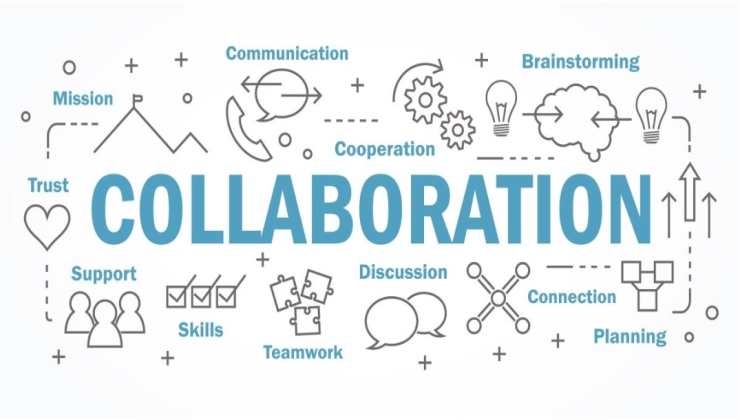Collaboration lies at the heart of human interaction, enabling individuals, teams, and organizations to achieve shared goals and aspirations. Whether in the workplace, academia, or community settings, effective collaboration fosters innovation, creativity, and synergy among diverse stakeholders. In this article, we delve into the principles and practices of collaboration, offering insights and strategies for mastering the art of working together.
Understanding Collaboration:
Definition and Concept:
Collaboration refers to the process of individuals or groups working together towards a common purpose or goal. It involves sharing resources, ideas, and responsibilities to achieve mutual benefit and success. Collaboration is characterized by communication, cooperation, and coordination among participants, leading to greater efficiency and effectiveness in problem-solving and decision-making.
Key Elements:
Successful collaboration is built upon several key elements, including trust, respect, communication, and accountability. Trust forms the foundation of collaboration, fostering openness, honesty, and mutual reliance among team members. Respect ensures that all voices are heard and valued, while effective communication enables information sharing and alignment of goals. Accountability holds individuals accountable for their actions and commitments, ensuring that everyone contributes to the collective effort.
Principles of Effective Collaboration:
Shared Vision and Goals:
Effective collaboration begins with a shared vision and clear, achievable goals. Collaborators must align their objectives and aspirations to ensure unity of purpose and direction. By articulating a common vision and setting SMART (Specific, Measurable, Achievable, Relevant, Time-bound) goals, collaborators can focus their efforts and resources towards a collective vision of success.
Open Communication and Transparency:
Open communication is essential for fostering trust, building relationships, and facilitating information sharing among collaborators. By encouraging open dialogue, active listening, and constructive feedback, collaborators can exchange ideas, resolve conflicts, and build consensus more effectively. Transparency ensures that all stakeholders have access to relevant information and insights, promoting accountability and integrity in the collaborative process.
Strategies for Effective Collaboration:
Establish Clear Roles and Responsibilities:
Clarifying roles and responsibilities is essential for ensuring clarity and accountability within a collaborative endeavor. By defining each participant’s role, scope of work, and areas of expertise, collaborators can leverage individual strengths and expertise to maximize collective impact. Using OKR software, teams can effectively align their objectives and key results, ensuring that each role is clearly tied to organizational goals. Regularly revisiting and refining roles and responsibilities through the use of OKR software helps maintain alignment and cohesion throughout the collaboration.
Promote Diversity and Inclusion:
Embracing diversity and inclusion is critical for fostering innovation, creativity, and resilience in collaboration. By welcoming diverse perspectives, backgrounds, and experiences, collaborators can enrich the collective intelligence and problem-solving capabilities of the group. Creating an inclusive environment where all voices are heard and valued promotes trust, engagement, and collaboration among participants.
In conclusion, collaboration is a powerful force for driving positive change and achieving shared goals in various contexts. By embracing the principles of collaboration and implementing strategies for effective teamwork, individuals, teams, and organizations can harness the collective potential of diverse stakeholders to address complex challenges and seize opportunities for growth and innovation. Whether in the workplace, academia, or community settings, mastering the art of collaboration is essential for building stronger relationships, fostering creativity, and achieving sustainable success in an interconnected world.
Collaboration, the act of individuals or groups working together towards a common goal, is a cornerstone of human interaction and achievement. Whether in professional settings, academic environments, or community initiatives, collaboration plays a pivotal role in driving innovation, fostering teamwork, and achieving shared objectives. However, like any endeavor, collaboration comes with its own set of advantages and disadvantages. In this article, we delve into the strengths and weaknesses of collaboration, offering insights into its complexities and considerations.
Advantages of Collaboration:
Synergy and Innovation:
Collaboration fosters synergy by bringing together diverse perspectives, skills, and experiences. When individuals collaborate, they pool their collective knowledge and expertise, leading to innovative solutions and creative breakthroughs that may not have been possible through individual effort alone. By combining different viewpoints and approaches, collaborators can generate fresh ideas and tackle complex problems more effectively.
Enhanced Problem-Solving:
Collaboration enables teams to leverage the collective intelligence and problem-solving capabilities of multiple stakeholders. By soliciting input from various perspectives and disciplines, collaborators can identify blind spots, uncover hidden opportunities, and bandar slot online develop robust solutions that address multifaceted challenges. Through brainstorming sessions, feedback loops, and iterative processes, collaboration encourages critical thinking and strategic decision-making.
Disadvantages of Collaboration:
Complexity and Coordination:
Collaboration introduces complexity and coordination challenges, particularly when managing large teams or diverse stakeholders. Coordinating schedules, aligning priorities, and reconciling conflicting viewpoints can be time-consuming and resource-intensive, leading to delays and inefficiencies in the collaborative process. Without clear communication and effective leadership, collaboration may result in confusion, ambiguity, and frustration among participants.
Potential for Conflict:
Collaboration can give rise to interpersonal conflicts, disagreements, and power struggles among team members. Differences in communication styles, working preferences, and personality traits may lead to misunderstandings and tensions within the group. Unresolved conflicts can undermine trust, cohesion, and morale, hindering progress and stifling creativity in the collaborative environment.
In conclusion, collaboration offers numerous advantages, including synergy, innovation, and enhanced problem-solving capabilities. By leveraging the collective intelligence and expertise of diverse stakeholders, collaboration enables teams to achieve greater results and make meaningful contributions to their respective fields. However, collaboration also presents challenges, such as complexity, coordination, and the potential for conflict. By understanding the strengths and weaknesses of collaboration and implementing strategies to mitigate its drawbacks, individuals, teams, and organizations can harness the power of working together to achieve shared goals and aspirations. Ultimately, effective collaboration requires a balance of communication, cooperation, and compromise, as well as a shared commitment to mutual success and collective achievement.

Introduction:
Collaboration is the cornerstone of success in many endeavors, whether it be in the workplace, academia, or community projects. Effective teamwork relies on a combination of communication, coordination, and cooperation among team members. In this article, we’ll explore a variety of tips and tricks to help individuals and teams maximize their collaborative potential and achieve shared goals with ease.
1. Establish Clear Goals and Expectations:
Define clear, measurable goals and expectations for the collaborative effort from the outset. Ensure that all team members have a shared understanding of the project’s objectives, timelines, and deliverables. Clarity in goals helps align efforts and keeps everyone focused on the collective mission.
2. Communicate Openly and Effectively:
Foster open communication channels where team members feel comfortable sharing ideas, concerns, and feedback. Utilize various communication tools and platforms to facilitate real-time collaboration, whether it’s through email, video conferencing, or project management software. Active listening and constructive dialogue are essential for building trust and rapport among collaborators.
3. Establish Roles and Responsibilities:
Clarify roles and responsibilities within the team to prevent confusion and duplication of efforts. Assign tasks based on individual strengths, expertise, and interests, ensuring a balanced distribution of workload. Regularly revisit and update roles as needed to adapt to changing project dynamics and priorities.
4. Foster Trust and Respect:
Cultivate a culture of trust and respect within the team by valuing each member’s contributions and perspectives. Encourage open-mindedness, empathy, and appreciation for diversity, recognizing that every team member brings unique insights and experiences to the table. Trust is the foundation of effective collaboration and is essential for building strong relationships among team members.
5. Embrace Flexibility and Adaptability:
Remain flexible and adaptable in the face of changing circumstances and unforeseen challenges. Be willing to adjust timelines, strategies, and approaches as needed to overcome obstacles and seize opportunities. Embrace a growth mindset that values learning, experimentation, and continuous improvement throughout the collaborative process.
6. Foster a Positive Team Culture:
Create a positive and inclusive team culture that celebrates achievements, fosters camaraderie, and boosts morale. Recognize and reward individual and collective accomplishments, whether it’s through verbal praise, team outings, or small tokens of appreciation. A supportive team environment promotes motivation, engagement, and a sense of belonging among collaborators werdaan.
7. Encourage Constructive Feedback:
Foster a culture of constructive feedback where team members feel empowered to offer and receive feedback in a respectful and constructive manner. Encourage peer-to-peer feedback sessions, performance reviews, and post-project evaluations to identify strengths, areas for improvement, and lessons learned. Feedback helps drive continuous growth and development within the team tvplutos.
Conclusion:
Effective collaboration requires a combination of clear communication, mutual respect, and shared accountability among team members. By implementing these tips and tricks for effective teamwork, individuals and teams can harness the power of collaboration to achieve greater results, drive innovation, and make a positive impact in their respective domains. Whether in the workplace, classroom, or community, mastering the art of collaboration is key to unlocking collective potential and achieving success together dreamchaserhub.


